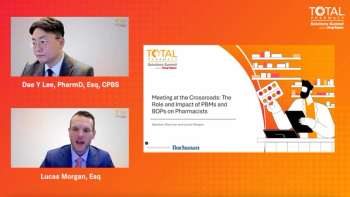
Too many pharmacy schools? One dean says no
Recently, the Chapman University School of Pharmacy (CUSP) received its accreditation as the first pharmacy school in Orange County, CA. It will begin accepting students in September 2015 for an eight trimester accelerated doctor of pharmacy degree program. We asked CUSP’s Founding Dean Ronald P. Jordan, RPh, FAPhA, to address concerns of pharmacists that an abundance of pharmacy schools is producing a glut of pharmacists, higher industry unemployment, and will eventually drive down salaries.
Very few Drug Topics’ stories receive as much reader response as those announcing new pharmacy schools. In recent months, we’ve told you about new schools at
Recently, the
Ronald Jordan, dean CUSPWe asked CUSP’s Founding Dean
Are there too many pharmacy schools?
NO! I’m optimistic about the broad range of opportunities and demand that will be there for pharmacists who are committed to: entrepreneurial lifelong learning, adaption to change, high performance in team work aimed at the grand challenges of health, and a compassionate focus on making a positive difference in people’s lives.
Schools that develop with the requisite resources, facilities, and strategic plans to remain committed to excellent personalized development of pharmacists will thrive as long as they focus on instilling the compassion, competencies, skills, and attitudes we need for the profession in the future. I think there is plenty of room for more new schools with these plans.
At the American Association of Colleges of Pharmacy we just learned the association is working on proposing a new brand for the profession - one that has a straightforward promise of what we deliver and is then consistently delivered by the profession. The brand tagline is “Pharmacists help people live healthier, better lives.” There is a growing and enormous opportunity for pharmacists who make that commitment to live by this brand every day, no matter where they work, practice, or live their life.
What is the demonstrated demographic/statistical need for Chapman University School of Pharmacy?
Chapman leaders looked at the 3.5 million residents of Orange County, CA, where no pharmacy school currently exists. They noted that Orange County was the largest supplier of pharmacy applicants as a county - nationwide - for a number of years. And, even more precisely, in Irvine, where Chapman chose to open its new Harry and Diane Rinker Health Sciences Campus, one finds some of the nation’s leading pharmacy education feeder schools.
Another important consideration was the enormous level of cultural and socioeconomic diversity in the county, which boasts the largest populations of some ethnic communities outside the largest cities in those native countries, thriving innovative industry, personal wealth, and sadly simultaneous high rates of poverty and healthcare needs.
We also noted in early 2012 that the Pharmacy Manpower Aggregate Demand Index, which gauges need as accurately as any predictor might in an incredibly complex industry, was trending toward the upper half of balance of demand and need toward demand-need imbalance with the beginning signs of moderate demand. Having seen the great recession effects on housing in Orange County and the early stages of recovery in CA, it was clear to us that demand would grow. Many health-delivery organizations are transforming themselves toward the well-known “Triple Aim.” They advised this would increase pharmacists’ opportunities in heretofore unforeseen areas.
Chapman University is committed to Orange County and directed by trustees who want us to act as an engine for growth in the region. As I was introduced to the top leaders of Orange County’s four large health systems, we also noted they were all engaged in transformation toward providing a continuous model of health improvement both inside and beyond their organization’s walls in the county. It was clear that advanced practice pharmacy had plenty of room to grow and that existing delivery institutions were underutilized and underserved by pharmacy higher education in California thus far.
Where do you anticipate Chapman pharmacy graduates being employed?
We will develop students for a broad range of pharmacist employment opportunities in existing practice, advanced practice, entrepreneurial enterprise, the pharmaceutical, biotech, and medical device industries locally, nationally, and internationally, as well as help students on a path that will lead them to be future educators.
Students will engage in a discovery experience designed to increase their skills at finding solutions and evidence that will solve problems. They will be extraordinary, high-performing team members with the communication skills-including good listening- that will make them desired participants in many organizations that are striving to become highly reliable in the design and delivery of flawless patient care.
What do you say to pharmacists who complain that more pharmacy schools will lead to joblessness for many?
The shear demographic increases alone will ensure that drug distribution and management of those traditional functions will keep even the most ambivalent pharmacists in work. If pharmacists are committed to really add value to the healthcare system, and deliver services that improve the health and lives in their communities, they will always find work.
Maybe it will be in a new form of care delivery with the new graduates’ pioneers. Maybe it will be in the expanding community retail environment now that the recession has permitted continued growth and innovations in care. It might also be employment as part of an integrating community of health providers who focus on healthy lives and care for their immediate neighbors through reliable and accountable care organizations and institutions with broad reach.
To be an optimist and rise to these opportunities we need to make a serious new commitment to continuous learning and personal development, not just the necessary CE to tick the box on the state re-licensure form. Pharmacists should explore their gaps in knowledge, and explore emerging areas and reorganization of health systems.
The future for our profession is bright if pharmacists know the gaps they have and prepare themselves for precision medicine, a wider scope of drug administration, and zero fault, flawless or error-free drug delivery. Our goal is to keep everyone healthy and strive for zero patient harm or death as a result of care.
Ronald P. Jordan is a registered pharmacist and fellow of the American Pharmacists Association (APhA). He previously served as dean of the College of Pharmacy at the University of Rhode Island (URI) and as executive secretary of the Rhode Island State Crime Lab Commission. He is also a former president of APhA.
See also:
Get more like this from Drug Topics, click
Newsletter
Pharmacy practice is always changing. Stay ahead of the curve with the Drug Topics newsletter and get the latest drug information, industry trends, and patient care tips.











































































































































































































